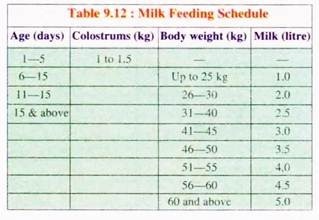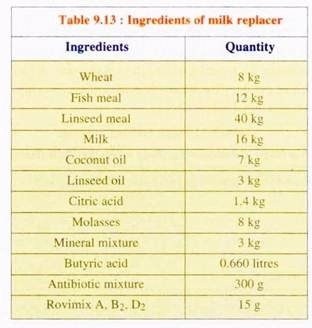In this article we will discuss about the factors responsible for calf mortality and measures to reduce it.
Factors Responsible for Calf Mortality:
Buffalo calf mortality rate under one month of age averages about 10% and varies from 3-30% in individual herds. Losses up to 50% have occurred in large dairy herds. A calf mortality rate of 20% can reduce net profit by 38%.
A number of factors considered responsible for this hazard are discussed below:
(1) Antibodies are not transferable from buffalo dam to her fetus through placental membranes and thus they are susceptible to various virulent diseases. In buffalo calves in spite of feeding colostrums, a low antibody titter exists. Immunoglobulin levels have been reported to be 29.73 mg/ml in day olds and the quantity increases to 35.66 mg/ml on the second day of life.
ADVERTISEMENTS:
On the other hand in one estimate it has been noted that colostrums which is the only source of immunoglobulin for the buffalo calf, contains 68.75 mg of immunoglobulin per ml on the first day, 23.75 mg/ml on the second day and 1.01 mg/ ml on the fifth day of lactation.
(2) Certain meteorological influences may have an effect on calf mortality rate. During the winter months, mortality may be associated with the effects of cold, wet and windy weather while during the summer it may be the hot, dry weather.
(3) Most of the deaths occur during autumn and winter months before the age of 3 months.
The causes of mortality in order of priority have been found:
ADVERTISEMENTS:
(a) Pneumonia,
(b) Enteritis,
(c) Toxaemia/Septicaemia,
(d) Worm infestation,
ADVERTISEMENTS:
(e) Bloat, etc.
(4) The cause of high mortality in male calves could also be due to neglecting tendency by the management, particularly regarding feeding.
Measures to Reduce Calf Mortality:
Some of the above prescribed management practices including feeding practices may be followed for minimizing the mortality rate.
(a) Housing:
In commercial herds, calves after weaning may be kept in groups in large pens where individual feeding is advocated. The small herds’ calves after weaning should be kept in separate pens (24 sq. ft) up to 3 months of age to avoid suckling instinct. The methods will eliminate the possible calf scour and parasitic infestation.
(b) Feeding Colostrums:
It is the milk secreted by the udder immediately after parturition and for the following 3-5 days. It contains 20% or more protein, a little more fat, 10 to 100 times more vitamin A, three times more of vitamin D and may be tinged pink due to blood corpuscles. It acts as a natural purgative for the calf, cleaning from its intestines the accumulated faecal matter.
Of much greater importance, it is through the medium of the colostrums, antibodies which protects against various bacteria, and viruses are supplied to the newborn calves.
The calves at birth after weaning should be fed colostrums within 2 hours and its feeding should continue for a period of five days at the rate of 1 to 1.5 kg per day. The details of milk feeding schedule are given in Table 9.12.
In case the dam does not give colostrums a substitute of equal nutritive value prepared from 2 eggs and an ounce of castor oil may be fed for building up resistance. It may be necessary to inject dam’s serum to such a calf for augmenting antibody titre in the body. The feed efficiency ratio of buffalo calves is as high as 1 kg gain per 1.16 kg dry matter. Milk feeding schedule is given in tabular form.
It is necessary to provide milk to weaned calves at body temperature preferably with supplements to make up the deficiencies of Fe, Cu. Mg, Zn and Mil. Green fodder containing up to 100 gram dry matter may be offered daily from 15 days of age onwards so that it stimulates early rumen development.
(c) Feeding Antibiotics:
Antibiotics are necessary in calves below 3 months of age to overcome certain stress conditions developed due to clinical or sub-clinical type of scour. These drugs are usually unnecessary in calves above 3 months as by this time rumen starts, functioning and antibiotics are liable to interfere in normal functioning of rumen microbes.
(d) Feeding Milk Replacer:
The objectives of feeding milk replacer to calves are primarily to reduce the cost of raising buffalo calves and also to save milk for human consumption. Details of milk replacer are given in Table 9.13.

